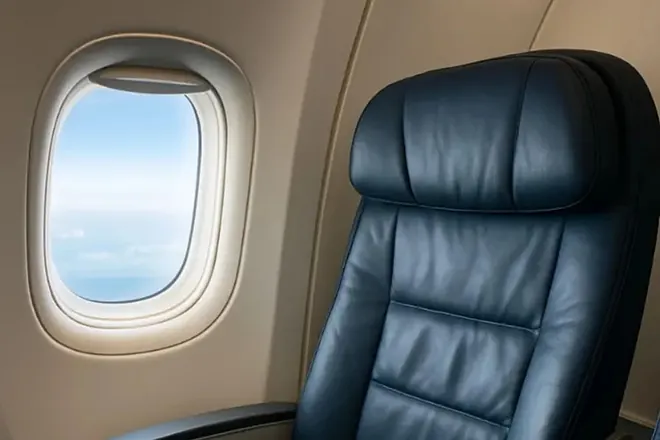For decades, airlines have found new ways to slice, price, and resell the flying experience. Once a straightforward ticket from A to B, air travel has been broken into pieces: checked bags, overhead bins, priority boarding, in-flight meals, Wi-Fi, seat selection. Each piece now comes with a cost.

But Delta Airlines and United Airlines are facing fresh legal scrutiny after passengers claim they paid extra for one of the most basic and cherished upgrades—a window seat—only to find themselves staring at a wall. A class action lawsuit filed in federal court in California accuses the airlines of false advertising and unfair business practices, reigniting a bitter debate about how transparent airlines are when charging for add-ons.
The Case: A Window Seat Without a Window
According to the complaint, passengers paid between $20 and $75 per ticket for what airlines marketed as window seats. These were labeled as premium “view” options during the booking process. When passengers boarded, though, they discovered their seats pressed up against solid fuselage panels with no windows.
The lawsuit argues that both airlines knowingly charged for a benefit that didn’t exist:
- Airlines have precise knowledge of every aircraft’s interior configuration.
- They can identify down to the row and seat which positions have windows and which don’t.
- Yet, according to the plaintiffs, neither Delta nor United disclosed this lack of visibility to customers when upselling “window” seats.
The plaintiffs’ attorneys call this deceptive seat marketing, an attempt to take advantage of rushed booking processes where travelers often don’t have the time or clarity to research whether the promised perk is actually there.
The lawsuit seeks financial compensation for passengers and a requirement that the airlines correct their booking platforms to clearly indicate when a so-called “window seat” doesn’t come with a window.
Why This Lawsuit Matters
On the surface, the complaint sounds almost comical—people suing over a missing view. But it touches a nerve in an industry where ancillary fees have ballooned into billions of dollars in revenue, often at the expense of transparency.
- In 2023, U.S. airlines made over $8 billion from seat selection fees alone, according to U.S. Department of Transportation (DOT) data.
- The DOT has fielded thousands of passenger complaints in recent years about misleading seat maps, hidden charges, and surprise fees.
- Consumer watchdog groups have long argued that airlines exploit the booking process by pressuring travelers into add-ons without giving them full information.
“Passengers aren’t just paying for transportation anymore,” said one aviation analyst. “They’re paying for the illusion of choice. This case is about what happens when even that illusion breaks.”
A History of Seat Fee Controversies
This isn’t the first time airlines have faced backlash for charging extra without delivering on the promise.
- Families and seat-blocking: Several lawsuits and regulatory proposals have targeted airlines for separating families during booking, then charging fees to seat parents next to their children.
- “Preferred” seating with no perks: Consumer groups have criticized airlines for labeling certain aisle or middle seats as “preferred” and charging extra, even when they offered no additional legroom or benefits.
- Southwest’s “early boarding” controversy: Though not a traditional seat fee, Southwest has faced challenges over its early check-in charges, which don’t always guarantee the promised boarding advantage.
The window seat lawsuit fits neatly into this lineage: customers paying extra for a specific experience only to find it stripped of the very feature they paid for.
How Airlines Sell Seats
Part of the issue lies in the opaque booking process. When choosing seats, most airline websites and mobile apps display a diagram of the aircraft. Seats are shaded or labeled depending on availability and cost.
But here’s the catch:
- Seat maps rarely show window alignments with precision. A “window” seat might look aligned with an opening on the diagram but in reality sit against a blank panel.
- Terminology is vague. Labels like “preferred,” “premium,” or “extra” are left to interpretation, often leading travelers to assume they’ll get something more than they actually do.
- Dynamic pricing pressures passengers. Fees change by flight, route, and demand. This makes it harder for passengers to resist paying, since they feel they might lose out if they don’t act fast.
In this case, the lawsuit claims the airlines went a step further by explicitly marketing these windowless spots as “view seats”, creating a clear mismatch between description and reality.
Regulatory Pressure on Airlines
The U.S. government has been eyeing airline fees for years, but progress has been slow. The Biden administration and the DOT have introduced several measures to curb deceptive practices:
- Proposed “junk fee” rules: The DOT has pushed for clearer upfront disclosures of fees, including seat charges, baggage costs, and family seating.
- Crackdown on misleading advertising: Regulators are working to require airlines to show the full cost of travel upfront instead of hiding add-ons until the final stages of booking.
- Family seating guarantee: In 2023, the DOT pressured several major airlines into pledging free adjacent seating for children under 13 traveling with their parents.
If this lawsuit succeeds, it could set a legal precedent for requiring airlines to provide explicit seat information, such as whether a window seat has an actual window.
The Consumer Angle: Why Passengers Are Fed Up
Travelers’ frustration is less about the $20–$75 fee itself and more about trust. Air travel has become synonymous with nickel-and-diming, and passengers are growing weary of being squeezed for every preference.
A few examples of passenger sentiment:
- Reddit forums regularly feature travelers warning others to “Google your plane’s seat map before you pay.”
- Sites like SeatGuru exist almost entirely to help passengers avoid paying for dud seats.
- Consumer surveys show that trust in U.S. airlines hovers near historic lows, with hidden fees and misleading pricing among the top complaints.
This lawsuit plays into that wider discontent, and it wouldn’t be surprising if other passenger groups or advocacy organizations piggyback on the momentum.
What Happens Next
Both Delta and United have so far declined to comment publicly on the case. Sources close to the airlines told reporters they will “review the lawsuit” before responding in court.
Legal experts note that outcomes could range from:
- Settlement payouts to affected passengers.
- A court order requiring airlines to change their booking systems.
- Or, if dismissed, renewed debate over whether airline fee transparency should be legislated rather than litigated.
Given the class action format, the case could cover thousands of passengers who unknowingly paid for windowless seats over the years. That alone makes the financial stakes significant for the airlines.
Bigger Picture: The Cost of Transparency
This case isn’t really about windows—it’s about honesty. Passengers understand that airlines charge for extras; what they don’t accept is paying for something that doesn’t exist.
If the lawsuit forces Delta and United to overhaul their seat maps, the ripple effect could pressure the entire industry to provide clearer, more accurate booking information.
For travelers, that could mean:
- Seeing whether a seat actually has a window before paying.
- Knowing if a “preferred” seat has any real advantage.
- Avoiding unnecessary fees by understanding exactly what’s included.
For airlines, though, greater transparency threatens a lucrative business model built on ambiguity and impulse upselling. The push and pull between these forces will define the next stage of the seat fee wars.
A Missing View, A Bigger Fight
The lawsuit against Delta and United Airlines may sound like a quirky complaint about missing windows, but it goes to the heart of how airlines treat their customers. Charging extra for comfort and choice is one thing; charging extra for nothing is another.
As the case moves through court, it’s not just passengers in California watching closely. Consumer advocates, regulators, and millions of flyers worldwide see it as a test of whether airlines can continue profiting off technicalities—or whether transparency will finally win a seat by the window.







